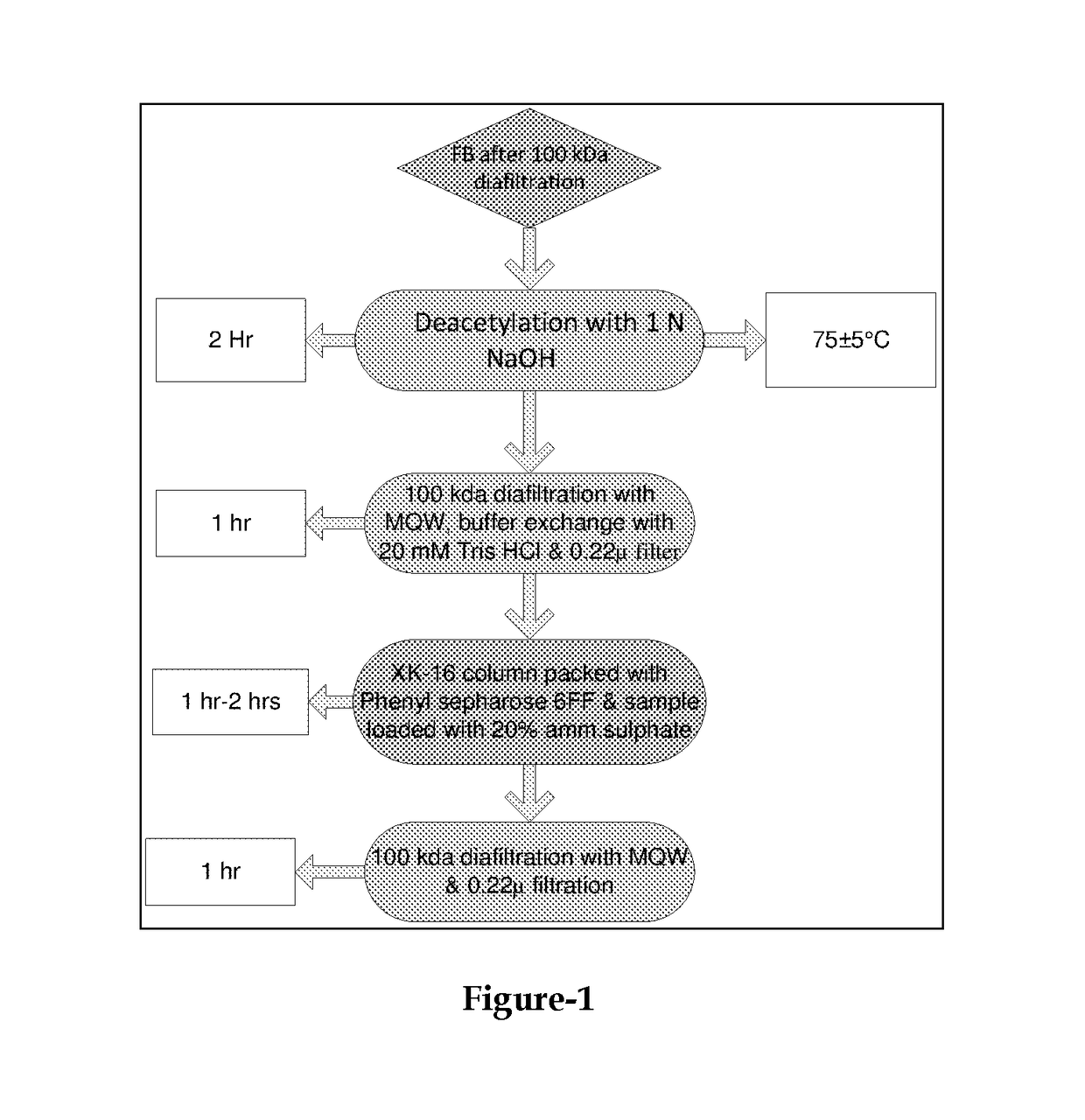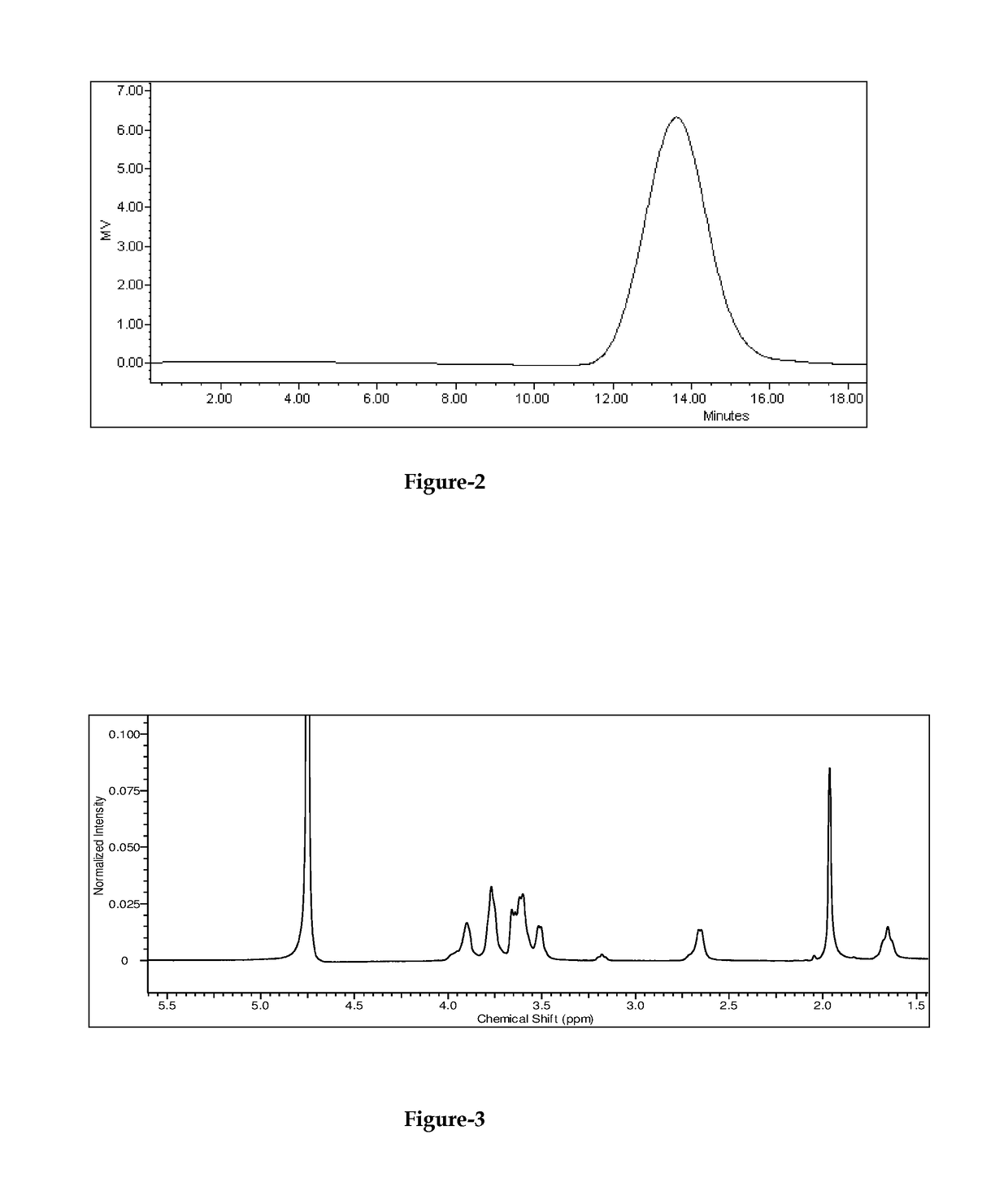Downstream process for purifying polysaccharides
a technology of neisseria meningitidis and polysaccharide, which is applied in the direction of biochemistry apparatus and processes, centrifugal force sediment separation, ultrafiltration, etc., can solve the problems of high cost, long working hours, and inability to define a purification process with extremely reduced time lines, so as to reduce the total number of steps and reduce the cost
- Summary
- Abstract
- Description
- Claims
- Application Information
AI Technical Summary
Benefits of technology
Problems solved by technology
Method used
Image
Examples
example-1
Polysaccharide Purification Using Anionic Detergent with Tris Buffer and Hydrophobic Interaction Chromatography (HIC):
[0039]The diafiltered and concentrated FB having the crude polysaccharide is processed with anionic detergent, such as, sodium deoxycholate at a concentration 0.3% to 0.6% (w / v) and incubated at 50° C.-60° C. for 1 hour. Subsequently it is cooled to below 40° C. followed by concentration and diafiltration of the crude polysaccharide with 0.1 m2 poly ether sulfone (PES) membrane, with 6-8 volumes of milliQ water (MQW).
[0040]Deacetylation is then performed on the crude polysaccharide with 0.5M sodium hydroxide (NaOH) at 50° C. for 10 hours. Subsequently it is cooled to below 40° C. followed by diafiltration and concentration of the crude polysaccharide simultaneously with 6-8 volumes of MQW and 20 mM Tris HCL buffer using 0.1 m2 PES membrane. Afterwards the polysaccharide is further purified by Hydrophobic Infraction Chromatography (HIC), Such as, Phenyl sepharose 6 Fa...
example-2
Polysaccharide Purification Using Anionic Detergent with HEPES Buffer (4-(2-Hydroxyethyl)-1-Piperazineethanesulfonic Acid) and Hydrophobic Interaction Chromatography (HIC):
[0041]The diafiltered and concentrated FB having the crude polysaccharide is processed with anionic detergent, for example, sodium deoxycholate at a concentration 0.3% to 0.6% (w / v) and incubated at 50° C.-60° C. for 1 hour. Subsequently it is cooled to below 40° C. followed by concentration and diafiltration of the crude polysaccharide with 0.1 m2 poly ether sulfone (PES) membrane, with 6-8 volumes of MQW.
[0042]Deacetylation is then performed on the crude polysaccharide with 0.5M sodium hydroxide (NaOH) at 50° C. for 10 hours. Subsequently it is cooled to below 40° C. followed by diafiltration and concentration of the crude polysaccharide simultaneously with 6-8 volumes of MQW and 20 mM HEPES containing 3M NaCl buffer using 0.1 m2 PES membrane. Afterwards the polysaccharide is further purified by Hydrophobic Inte...
example-3
Polysaccharide Purification Using Sodium Hydroxide with HEPES Buffer ((4-(2-Hydroxyethyl)-1-Piperazineethanesulfonic Acid) and Hydrophobic Interaction Chromatography (HIC):
[0043]The diafiltered and concentrated FB having the crude polysaccharide is deacetylated with 0.8M NaOH for 6 hours at 80° C. Subsequently it is cooled to below 40° C. followed by diafiltration and concentration of the crude polysaccharide simultaneously with 6-8 volumes of MQW and 20 mM HEPES containing 3M NaCl buffer using 0.1 m2 PES membrane. Afterwards the polysaccharide is further purified by Hydrophobic Interaction Chromatography (HIC), Such as, Phenyl sepharose 6 Fast Flow. Concentration and diafiltration of the purified polysaccharide was performed with 0.1 m2 PES membrane, with 6-8 volumes of MQW. Consequently, sterile filtration was done with 0.22 μm filter and the final purified polysaccharide is stored at −20° C. The total time taken to purify the polysaccharide including HIC chromatography using the ...
PUM
| Property | Measurement | Unit |
|---|---|---|
| temperature | aaaaa | aaaaa |
| time | aaaaa | aaaaa |
| time | aaaaa | aaaaa |
Abstract
Description
Claims
Application Information
 Login to View More
Login to View More - R&D
- Intellectual Property
- Life Sciences
- Materials
- Tech Scout
- Unparalleled Data Quality
- Higher Quality Content
- 60% Fewer Hallucinations
Browse by: Latest US Patents, China's latest patents, Technical Efficacy Thesaurus, Application Domain, Technology Topic, Popular Technical Reports.
© 2025 PatSnap. All rights reserved.Legal|Privacy policy|Modern Slavery Act Transparency Statement|Sitemap|About US| Contact US: help@patsnap.com


